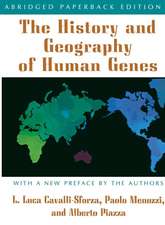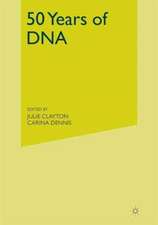Handbook of Glycosyltransferases and Related Genes
Editat de Naoyuki Taniguchi, Koichi Honke, Minoru Fukuda, Hisashi Narimatsu, Yoshiki Yamaguchi, Takashi Angataen Limba Engleză Hardback – 4 mar 2014
The first edition of the Handbook of Glycosyltransferases and Related Genes, published in 2002, contained descriptions of more than 100 mammalian genes by over 100 scientists who originally isolated and/or cloned these genes. Since then, there has been a growing body of evidence concerning the roles of glycosyltransferases, and additional glycosyltransferases have been identified. Now more than 200 glycosyltransferases have been isolated from mammalian tissue, corresponding to approximately 1–2% of the total human genome. Some have been found to be involved in development and reproduction, signal transduction, cell death, higher nervous functioning, immunity, and other important biological processes. Glycosyltransferases have also been implicated in the development of lifestyle diseases such as diabetes, cancer, chronic obstructive lung disease (COPD), neuromuscular diseases, and infectious diseases.
A functional glycomics approach using gene targeting in mice and analytical methods utilizing glycan arrays, lectin arrays, HPLC, and mass spectrometry identified the target glycoprotein(s) on which glycans are attached by the catalytic reaction of glycosyltransferases. Most of the target proteins have been shown to be cell surface membrane proteins such as growth factor receptors and transporters. The three-dimensional structures of some glycosyltransferases have also been characterized, making it possible to classify them into retaining and inverting enzymes. Such structural information is also included in this invaluable new edition.
Preț: 2701.74 lei
Preț vechi: 3554.93 lei
-24% Nou
Puncte Express: 4053
Preț estimativ în valută:
517.05€ • 537.81$ • 426.85£
517.05€ • 537.81$ • 426.85£
Carte tipărită la comandă
Livrare economică 10-16 aprilie
Preluare comenzi: 021 569.72.76
Specificații
ISBN-13: 9784431542391
ISBN-10: 4431542396
Pagini: 1824
Ilustrații: XXXVIII, 1707 p. 205 illus., 75 illus. in color. In 3 volumes, not available separately.
Dimensiuni: 155 x 235 x 119 mm
Greutate: 3.02 kg
Ediția:2nd ed. 2014
Editura: Springer
Colecția Springer
Locul publicării:Tokyo, Japan
ISBN-10: 4431542396
Pagini: 1824
Ilustrații: XXXVIII, 1707 p. 205 illus., 75 illus. in color. In 3 volumes, not available separately.
Dimensiuni: 155 x 235 x 119 mm
Greutate: 3.02 kg
Ediția:2nd ed. 2014
Editura: Springer
Colecția Springer
Locul publicării:Tokyo, Japan
Public țintă
ResearchCuprins
Part 1 Glucosyltransferases.- 1 Beta-1,3-glucosyltransferase (B3GALTL).- 2 Protein O-glucosyltransferases rumi (RUMI).- 3 UDP-glucose:ceramide glucosyltransferase (UGCG).- 4 UDP-glucose:glycoprotein glucosyltransferase 1,2 (UGGT1,2).- Part 2 Galactosyltransferases.- 5 Alpha 1,3-galactosyltransferase 2, pseudogene (A3GALT2P).- 6 Core 1 beta 3Galactosyltransferase (C1GalT1, T-synthase) and its Specific Molecular Chaperone Cosmc (C1GalT1C1).- 7 Glycoprotein alpha 1,3-galactosyltransferase 1, pseudogene (GGTA1P).- 8 UDP-Gal:betaGal beta 1,3-galactosyltransferase polypeptide 6 (B3GALT6).- 9 UDP-Gal:betaGlcNAc beta 1,3-galactosyltransferase, polypeptide 1,2 (B3GALT1,2).- 10 UDP-Gal:betaGlcNAc beta 1,3-galactosyltransferase, polypeptide 4 (B3GALT4).- 11 UDP-Gal:betaGlcNAc beta 1,3-galactosyltransferase, polypeptide 5 (B3GALT5).- 12 UDP-Gal:betaGlcNAc beta 1,4- galactosyltransferase, polypeptide 1 (B4GALT1).- 13 UDP-Gal:betaGlcNAc beta 1,4- galactosyltransferase, polypeptide 2-6; xylosylprotein beta 1,4-galactosyltransferase, polypeptide 7 (galactosyltransferase I) (B4GALT2-7).- 14 UDP-Gal:ceramide galactosyltransferase (UGT8).- 15 UDP-Gal:lactosylceramide alpha 1,4-galactosyltransferase (A4GALT).- Part 3 Mannosyltransferases.- 16 Protein O-mannosyl-transferase 1,2 (POMT1,2).- Part 4 N-Acetylglucosaminyltransferases.- 17 Alpha-1,4-N-acetylglucosaminyltransferase (A4GNT).- 18 Beta-1,3-galactosyl-O-glycosyl-glycoprotein beta-1,6-N-acetylglucosaminyltransferase 3 (GCNT3).- 19 Beta-1,3-galactosyl-O-glycosyl-glycoprotein beta-1,6-N-acetylglucosaminyltrasnsferase 1 (GCNT1) (C2GnT-L)and Beta-1,3-galactosyl-O-glycosyl-glycoprotein beta-1,6-N-acetylglucosaminyltrasnsferase 3 (GCNT4) (C2GnT-T).- 20 Fringe (UDP-GlcNAc: O-fucosylpeptide ß1,3 N-acetylglucosaminyltransferase).- 21 Mannosyl (alpha-1,3-)-glycoprotein beta-1,2-N-acetylglucosaminyltransferase (MGAT1).- 22 Mannosyl (alpha-1,3-)-glycoprotein beta-1,4-N-acetylglucosaminyltransferase, isozyme A,B (MGAT4A,B).- 23 Mannosyl (alpha-1,3[6?]-)-glycoprotein beta-1,4-N-acetylglucosaminyltransferase, isozyme C (putative) (MGAT4C).- 24 Mannosyl (alpha-1,6-)-glycoprotein beta-1,2-N-acetylglucosaminyltransferase (MGAT2).- 25 Mannosyl (alpha-1,6-)-glycoprotein beta-1,6-N-acetyl-glucosaminyltransferase, isozyme B (MGAT5B).- 26 Mannosyl (alpha-1,6-)-glycoprotein beta-1,6-N-acetyl-glucosaminyltransferase (MGAT5).- 27 Mannosyl (beta-1,4-)-glycoprotein beta-1,4-N- acetylglucosaminyltransferase (MGAT3); β1,4-N- Acetylglucosaminyltransferase III (GnT-III, GlcNAc-T III).- 28 N-acetyllactosaminide beta-1,6-N-acetylglucosaminyl-transferase (GCNT2) (IGnT).- 29 O-linked N-acetylglucosamine (GlcNAc) transferase (UDP-N-acetylglucosamine:polypeptide-N-acetylglucosaminyl transferase) (OGT).- 30 Protein O-linked-mannose beta-1,2-N-acetylglucosaminyltransferase 1 (POMGNT1).- 31 UDP-GlcNAc: beta-Gal beta1,3-N-acetylglucosaminyltransferase 6 (B3GNT6) (Core 3 synthase, C3GnT).- 32 UDP-GlcNAc:betaGal beta-1,3-N-acetylglucosaminyltransferase 1 (B3GNT1), i-enzyme (iGnT).- 33 UDP-GlcNAc:betaGal beta-1,3-N-acetylglucosaminyltransferase 2 (B3GNT2).- 34 UDP-GlcNAc:betaGal beta-1,3-N-acetylglucosaminyltransferase 3 (B3GNT3).- 35 UDP-GlcNAc:betaGal beta-1,3-N-acetylglucosaminyltransferase 5 (B3GNT5, Lc3Cer synthase).- 36 UDP-GlcNAc:betaGal beta-1,3-N-acetylglucosaminyltransferase 7 (B3GNT7).- 37 UDP-GlcNAc:betaGal beta-1,3-N-acetylglucosaminyltransferase 8 (B3GNT8).- Part 5 N-Acetylgalactosaminyltransferases.- 38 Beta-1,4 N-acetylgalactosaminyltransferase 1,2 (B4GALNT1,2).- 39 Beta1,3-N-Acetylgalactosaminyltransferase 2 (B3GALNT2).- 40 Beta1,4-N-acetylgalactosaminyltransferase-3 (B4GALNT3) and beta1,4-N-acetylgalactosaminyltransferase-4 (B4GALNT4).- 41 Globoside alpha-1,3-N-acetylgalactosaminyltransferase 1 (GBGT1).- 42 Histo-blood Group A and B Transferases, Their Gene Structures, and Common O Group Gene Structures.- 43 Histo-blood Group A Variants, O Variants, and Their Alleles.- 44 UDP-GlcNAc:betaGal beta-1,3-N-acetylglucosaminyltransferase 4 (B3GNT4).- 45 UDP-N-acetyl-alpha-D-galactosamine:polypeptide N-acetylgalactosaminyltransferases (ppGalNAc-Ts).- Part 6 Fucosyltransferases.- 46 Fucosyltransferase 3. GDP-fucose lactosamine α1,3/4-fucosyltransferase. Lea and Leb histo-blood groups (FUT3, Lewis enzyme).- 47 Fucosyltransferase 4. GDP-fucose lactosamine α1,3-fucosyltransferase. Myeloid specific (FUT4).- 48 Fucosyltransferase 5. GDP-fucose lactosamine α3/4-fucosyltransferase (FUT5).- 49 Fucosyltransferase 6. GDP-fucose lactosamine α3-fucosyltransferase (FUT6).- 50 Fucosyltransferase 7. GDP-fucose lactosamine α1,3-fucosyltransferase. Sialyl-Lex specific (FUT7).- 51 Fucosyltransferase 8. GDP-fucose N-glycan core α6-fucosyltransferase (FUT8).- 52 Fucosyltransferase 9. GDP-fucose lactosamine α1,3-fucosyltransferase. Lex specific (FUT9).- 53 Fucosyltransferases 1, 2. GDP-fucose galactoside α2-fucosyltransferases. FUT1 or H blood group, FUT2 or ABH secretor status and Sec1 (FUT1, FUT2, Sec1).- 54 Fucosyltransferases 10, 11. GDP-fucose N-glycan core α1,3-fucosyltransferases (FUT10, FUT11).- 55 Fucosyltransferases 12, 13: Protein O-fucosyltransferases 1 and 2 (POFUT1, POFUT2).- Part 7 Sialyltransferases.- 56 ST3 beta-galactoside alpha-2,3-sialyltransferase 1 (ST3GAL1).- 57 ST3 beta-galactoside alpha-2,3-sialyltransferase 2 (ST3GAL2).- 58 ST3 beta-galactoside alpha-2,3-sialyltransferase 3 (ST3GAL3).- 59 ST3 beta-galactoside alpha-2,3-sialyltransferase 4 (ST3GAL4).- 60 ST3 beta-galactoside alpha-2,3-sialyltransferase 5 (ST3GAL5).- 61 ST3 beta-galactoside alpha-2,3-sialyltransferase 6 (ST3GAL6).- 62 ST6 beta-galactoside alpha-2,6-sialyltranferase 1 (ST6GAL1).- 63 ST6 beta-galactoside alpha-2,6-sialyltranferase 2 (ST6GAL2).- 64 ST6 N-acetylgalactosaminide alpha-2,6-sialyltransferase 1 (ST6GALNAC1).- 65 ST6 N-acetylgalactosaminide alpha-2,6-sialyltransferase 2 (ST6GALNAC2).- 66 ST6 N-acetylgalactosaminide alpha-2,6-sialyltransferase 3 (ST6GALNAC3).- 67 ST6 N-acetylgalactosaminide alpha-2,6-sialyltransferase 4 (ST6GALNAC4).- 68 ST6 N-acetylgalactosaminide alpha-2,6-sialyltransferase 5,6 (ST6GALNAC5,6).- 69 ST8 alpha-N-acetyl-neuraminide alpha-2,8-sialyltransferase 1 (ST8SIA1).- 70 ST8 alpha-N-acetyl-neuraminide alpha-2,8-sialyltransferase 2 (ST8SIA2).- 71 ST8 alpha-N-acetyl-neuraminide alpha-2,8-sialyltransferase 3 (ST8SIA3).- 72 ST8 alpha-N-acetyl-neuraminide alpha-2,8-sialyltransferase 4 (ST8SIA4).- 73 ST8 alpha-N-acetyl-neuraminide alpha-2,8-sialyltransferase 5 (ST8SIA5).- 74 ST8 alpha-N-acetyl-neuraminide alpha-2,8-sialyltransferase 6 (ST8SIA6).- Part 8 Glucuronyltransferases.- 75 Beta-1,3-glucuronyltransferase 1 (glucuronosyltransferase P); beta-1,3-glucuronyltransferase 2 (B3GAT1,2).- 76 Beta-1,3-glucuronyltransferase 3 (glucuronosyltransferase I) (B3GAT3).- Part 9 GAG polymerase and related enzymes.- 77 Chondroitin polymerizing factor, chondroitin polymerizing factor 2, chondroitin sulfate synthase 1,3 (CHPF, CHPF2, CHSY1, CHSY3).- 78 Chondroitin sulfate N-acetylgalactosaminyltransferase 1,2 (CSGALNACT1,2).- 79 Dermatan sulfate epimerases (DSE, DSEL).- 80 Exostoses (multiple)-like 1-3 (EXTL1-3).- 81 Exostosin 1,2(EXT1,2).- 82 Heparin-heparansulfate related GlcA C5-epimerase.- 83 Hyaluronan synthase 1-3 (HAS1-3).- 84 Xylosyltransferase I,II (XYLT1,2).- Part 10 Sulfotransferases.- 85 Carbohydrate sulfotransferase 10 (CHST10).- 86 Carbohydrate (chondroitin 4) sulfotransferase 11-13 (CHST11-13).- 87 Carbohydrate (chondroitin 6) sulfotransferase 3; carbohydrate (N-acetylglucosamine 6-O) sulfotransferase 7 (CHST3,7).- 88 Carbohydrate (keratan sulfate Gal-6) sulfotransferase 1 (CHST1).- 89 Carbohydrate (N-acetylgalactosamine 4-0) sulfotransferase 14 (CHST14).- 90 Carbohydrate (N-acetylgalactosamine 4-sulfate 6-O) sulfotransferase 15 (CHST15).- 91 Carbohydrate (N-acetylglucosamine 6-O) sulfotransferase 4 (CHST4).- 92 Carbohydrate (N-acetylglucosamine 6-O) sulfotransferase 5 and 6 (CHST5,6).- 93 Carbohydrate (N-acetylglucosamine-6-O) sulfotransferase 2(CHST2).- 94 Galactose-3-O-sulfotransferase 1-4 (GAL3ST1-4).- 95 Heparan sulfate 2-O-sulfotransferase (HS2ST).- 96 Heparan sulfate (glucosamine) 3-O-sulfotransferase 1-6 (HS3ST1-6).- 97 Heparan-sulfate 6-O-sulfotransferase 1-3 (HS6ST1-3).- 98 N-Acetylgalactosamine-4-sulfotransferase-1 (GalNAc-4-ST1, CHST8) and N-Acetylgalactosamine-4-sulfotransferase-2 (GalNAc-4-ST2, CHST9).- 99 N-deacetylase/N-sulfotransferase (heparan glucosaminyl) 1 (NDST1).- 100 N-deacetylase/N-sulfotransferase (heparan glucosaminyl) 2 (NDST2).- 101 N-deacetylase/N-sulfotransferase (heparan glucosaminyl) 3,4 (NDST3,4).- 102 Uronyl-2-sulfotransferase (UST).- Part 11 Glycosyltransferase-like proteins (inplicated in alpha-dystrogly).- 103 Fukutin and fukutin-related protein (FKRP).- 104 Like-glycosyltransferase; glycosyltransferase-like 1B (LARGE, GYLTL1B).- Part 12 GPI anchor biosynthesis.- 105 Glycosylphosphatidylinositol-N-acetylglucosaminyltransferase (GPI-GlcNAc transferase): A complex comprised of PIGA, PIGC, PIGH, PIGQ, PIGP, PIGY and DPM2.- 106 GPI mannose extension (PIGM, PIGV, PIGB, PIGZ).- Part 13 N-Glycan precursor biosynthesis, en-bloc transfer and processing.- 107 ALG mannosyltransferases, ER lumen = alpha linkage (ALG3,9,12).- 108 Dolichyl-phosphate (UDP-N-acetylglucosamine) N-acetylglucosaminephosphotransferase 1 (GlcNAc-1-P transferase) (DPAGT1).- 109 Glucosidase, alpha neutral AB; glucosidase II subunit beta (GANAB, PRKCSH, α-glucosidase II).- 110 Heterodimeric Alg13/Alg14 UDP-GlcNAc transferase (ALG13,14).- 111 Mannosidase, alpha, class 1 (MAN1A1 (Golgi alpha-mannnosidase IA), Man1A2 (Golgi alpha-mannosidase IB), MAN1B1(ER alpha-mannosidase I), MAN1C1 (Golgi alpha-mannosidase IC ).- 112 Mannosidase, alpha, class 2a1 (MAN2A1, Golgi α-mannosidase II).- 113 Mannosidase, alpha, class 2a2 (MAN2A2).- 114 Mannosyl-oligosaccharide glucosidase (Glucosidase I, MOGS).- 115 N-acetylglucosamine-1-phosphate transferase, gamma subunit; N-acetylglucosamine-1- (GNPTG, GNPTAB).- 116 N-acetylglucosamine-1-phosphodiester alpha-N-acetylglucosaminidase (NAGPA).- 117 OST complex (OST48, Ribophorin I, Ribophorin II, DAD1).- 118 The Alg1, Alg2, and Alg11 Mannosyltransferases of the Endoplasmic Reticulum.- Part 14 Nucleotide sugar transporters.- 119 Adenosine 3’-phospho 5’-phosphosulfate transporter 1,2 (PAPST1,2) (SLC35B2,3).- 120 GDP-fucose transporter 1 (SLC35C1).- 121 Solute carrier family 35 (CMP-sialic acid transporter), member A1 (SLC35A1).- 122 Solute carrier family 35 (UDP-galactose transporter), member A2 (SLC35A2).- 123 UDP-N-acetylglucosamine/UDP-glucose/GDP-mannose transporter (HFRC1) (SLC35D2).- 124 UDP-xylose and UDP-N-acetylglucosamine transporter (SLC35B4).- Part 15 Transferase donor substrate biosynthesis and related reactions.- 125 Cytidine monophosphate N-acetylneuraminic acid synthetase (CMAS).- 126 Cytidine monophospho-N-acetylneuraminic acid hydroxylase (CMAH).- 127 Dolichyl-phosphate beta-glucosyltransferase (ALG5).- 128 Dolichyl-phosphate mannosyltransferase polypeptide (DPM1-3).- 129 Fucokinase (FUK).- 130 Fucose-1-phosphate guanylyltransferase (FPGT ).- 131 GDP-mannose pyrophosphorylase A,B (GMPPA,B).- 132 Glucosamine-6 phosphate N-acetyltransferase (GNPNAT1 / GNA1).- 133 Glutamine--fructose-6-phosphate transaminase 1,2 (GFPT1,2).- 134 Mannose phosphate isomerase (MPI).- 135 N-acetylglucosamine kinase (NAGK).- 136 N-acetylneuraminic acid phosphatase (NANP).- 137 N-acetylneuraminic acid synthase (NANS).- 138 Phosphoglucomutase 3 (= phosphoacetylglucosamine mutase) (PGM3).- 139 Phosphomannomutase 1,2 (PMM1,2).- 140 Tissue specific transplantation antigen P35B (= GDP-4-keto-6-D-deoxymannose epimerase-reductase) (TSTA3).- 141 UDP-galactose-4-epimerase (GALE).- 142 UDP-GlcNAc-2-epimerase/ManNAc kinase (GNE).- 143 UDP-glucose 6-dehydrogenase (UGDH).- 144 UDP-glucuronate decarboxylase 1 (UXS1).- 145 UDP-N-acteylglucosamine pyrophosphorylase 1 (UAP1).- BM Appendix.- Map 1: Biosynthetic Pathways of N-Glycans.- Map 2: Biosynthetic Pathways of O-Glycans.- Map 3: Biosynthetic Pathways of Glycosphingolipids.- Map 4: Biosynthetic Pathways of Proteoglycans.- Map 5: Biosynthetic Pathways of GPI-Anchor.
Notă biografică
Naoyuki Taniguchi graduated from the Faculty of Medicine, Hokkaido University, and obtained his M.D. degree in 1967 and then his Ph.D. from the same university in 1972. He became an assistant professor in the Department of Preventive Medicine, Hokkaido University, and a visiting associate professor at the Cornell University Medical School, New York, in 1976. After returning to Japan, he became an associate professor at the Cancer Institute, Hokkaido University Medical School. In 1986 he became professor and chair of the Department of Biochemistry, Osaka University Medical School. After retirement from the medical school in 2006, he became an endowed chair professor at Osaka University. In the meantime, he launched the Systems Glycobiology Research Group at RIKEN, Advanced Science Institute (the former Frontier Science Program), in 2007, and since that time he has been the group director. He is focusing on the structure and function of glycans, especially the role of N-linked glycoproteins in relation to the mechanism of disease, biomarker discovery and therapeutics.
Dr. Taniguchi has published more than 500 papers in peer-reviewed journals and has served as chief editor for the Journal of Biochemistry. He has been an editorial board member for many journals such as Biochemical and Biophysical Research Communications , The Journal of Biological Chemistry, Proteomics, Glycobiology, and Glycoconjugate Journal, among others.
He received the International Glycoconjugate Organization (IGO) Award in 2001, the Medal with Purple Ribbon in 2005, the IUBMB Medal in 2009, the HUPO Distinguished Service Award in 2010, and the Japan Academy Award in 2011. Dr. Taniguchi is now the president of the Japan Consortium for Glycobiology and Glycotechnology and will become the president of the Society for Glycobiology in 2014.
Koichi Honke graduated from the Faculty of Medicine, Hokkaido University School, obtaining his M.D. there in 1983. Since he began his research at the Cancer Institute of the Hokkaido University Medical School in 1984 he has been studying the metabolism and function of glycolipids as well as glycoproteins. He worked at the Osaka Medical Center for Maternal and Child Health as chief researcher from 1995 to 1999 and in the Department of Biochemistry, Osaka University Medical School, as associate professor from 1999 to 2003. He was then promoted to full professor at the Kochi University Medical School in 2003. His major contribution has been purification, molecular cloning, and gene targeting of a glycan sulfotransferase responsible for the biosynthesis of sulfatides and discovery of the Gal 3-O-sulfotransferase gene family. His research focus now has shifted to the biogenesis of membrane microdomains with the establishment of a novel labeling method called EMARS for identification of cell surface molecular clustering in living cells.
Minoru Fukuda is a professor at the Sanford-Burnham Medical Research Institute in La Jolla, California, and an adjunct professor in the Department of Pathology at the University of California, San Diego. Dr. Fukuda earned his Ph.D. in biochemistry from the University of Tokyo in 1973 and completed post-doctoral research training at the Yale University School of Medicine. He was an assistant professor at the University of Washington and the Fred Hutchinson Cancer Research Center in Seattle, Washington, working with Dr. Senichiro Hakomori, before he was recruited to the Burnham Institute as director of the glycobiology program in 1984. In 1994–1995, Dr. Fukuda was also the biochemistry chair of the Institute of Medical Science, the University of Tokyo. Dr. Fukuda has published more than 280 original scientific papers, authored and edited many books, and served as executive editor and associate editor for Biochimica et Biophysica Acta (BBA) and Cancer Research, respectively. Dr. Fukuda received the Karl Meyer Award given by the Society for Glycobiology, The Mizutani Award, MERIT Award and Program Project Grant, and recently, the Alliance of Glycobiologists for Detection of Cancer from the National Cancer Institute, National Institutes of Health (NIH). His research focus is on the structure, biosynthesis, and function of glycoproteins. He is particularly interested in the tumor suppresser function of carbohydrates and heparan sulfate for cellular signals in cell–cell interaction.
Hisashi Narimatsu is a founder and the director of the Research Center of Medical Glycoscience (RCMG), a part of the National Institute of Advanced Industrial Science and Technology (AIST) in Japan, and is energetically leading comprehensive activities in glycoscience. He graduated from the School of Medicine and the Graduate School of Medicine at Keio University, where he received his M.D. and Ph.D., respectively. He successfully cloned the first glycosyltransferase, 1,4-galactosyltransferase, during his postdoc at the U.S. National Institutes of Health (NIH), and thereafter he has continued to devote his scientific career to finding and cloning many new glycosyltransferases. In 2000, he joined AIST and since then has been leading three national projects, i.e., the Glycogene Project, the Structural Glycomics Project, and the Medical Glycomics Project, to facilitate the progress of glycoscience.
Yoshiki Yamaguchi received his Ph.D. in 1998 at the Graduate School of Pharmaceutical Sciences, the University of Tokyo (under Professors Ichio Shimada and Yoji Arata). He continued his research as a postdoctoral research fellow and then as a research associate in the same group. From 2001 to 2007, he was a lecturer at Nagoya City University (under Professor Koichi Kato) and then moved to his current position at RIKEN, the Systems Glycobiology Research Group, as a team leader of the Structural Glycobiology Team. His current study focuses on structural analyses of glycoproteins and glycan-related proteins. He has been holding posts concurrently at Nagoya City University (from 2007) and at Tokyo Medical and Dental University (from 2008) as a visiting professor. He received Young Scientist Awards from GlycoTOKYO in 2006 and from the Japanese Society of Carbohydrate Research in 2007.
Takashi Angata received a Ph.D. degree in biochemistry from the Graduate School of Science, the University of Tokyo, in 1998. He has served as post-doctoral fellow to Professor Ajit Varki at the University of California, San Diego (1998–2003), research scientist at the National Institute of Advanced Industrial Science and Technology (AIST) in Japan (2003–2009), specially appointed associate professor at Osaka University (2009–2011), and now as team leader at the RIKEN Advanced Science Institute (2011–present).
Dr. Angata was a major contributor in the expansion of the Siglec family of sialic acid recognition proteins and made several seminal discoveries in the field, such as the concerted evolution of activating and inhibitory Siglecs as paired receptors. His current research is focused on the role of activating Siglecs in innate immunity and chronic diseases.
Dr. Taniguchi has published more than 500 papers in peer-reviewed journals and has served as chief editor for the Journal of Biochemistry. He has been an editorial board member for many journals such as Biochemical and Biophysical Research Communications , The Journal of Biological Chemistry, Proteomics, Glycobiology, and Glycoconjugate Journal, among others.
He received the International Glycoconjugate Organization (IGO) Award in 2001, the Medal with Purple Ribbon in 2005, the IUBMB Medal in 2009, the HUPO Distinguished Service Award in 2010, and the Japan Academy Award in 2011. Dr. Taniguchi is now the president of the Japan Consortium for Glycobiology and Glycotechnology and will become the president of the Society for Glycobiology in 2014.
Koichi Honke graduated from the Faculty of Medicine, Hokkaido University School, obtaining his M.D. there in 1983. Since he began his research at the Cancer Institute of the Hokkaido University Medical School in 1984 he has been studying the metabolism and function of glycolipids as well as glycoproteins. He worked at the Osaka Medical Center for Maternal and Child Health as chief researcher from 1995 to 1999 and in the Department of Biochemistry, Osaka University Medical School, as associate professor from 1999 to 2003. He was then promoted to full professor at the Kochi University Medical School in 2003. His major contribution has been purification, molecular cloning, and gene targeting of a glycan sulfotransferase responsible for the biosynthesis of sulfatides and discovery of the Gal 3-O-sulfotransferase gene family. His research focus now has shifted to the biogenesis of membrane microdomains with the establishment of a novel labeling method called EMARS for identification of cell surface molecular clustering in living cells.
Minoru Fukuda is a professor at the Sanford-Burnham Medical Research Institute in La Jolla, California, and an adjunct professor in the Department of Pathology at the University of California, San Diego. Dr. Fukuda earned his Ph.D. in biochemistry from the University of Tokyo in 1973 and completed post-doctoral research training at the Yale University School of Medicine. He was an assistant professor at the University of Washington and the Fred Hutchinson Cancer Research Center in Seattle, Washington, working with Dr. Senichiro Hakomori, before he was recruited to the Burnham Institute as director of the glycobiology program in 1984. In 1994–1995, Dr. Fukuda was also the biochemistry chair of the Institute of Medical Science, the University of Tokyo. Dr. Fukuda has published more than 280 original scientific papers, authored and edited many books, and served as executive editor and associate editor for Biochimica et Biophysica Acta (BBA) and Cancer Research, respectively. Dr. Fukuda received the Karl Meyer Award given by the Society for Glycobiology, The Mizutani Award, MERIT Award and Program Project Grant, and recently, the Alliance of Glycobiologists for Detection of Cancer from the National Cancer Institute, National Institutes of Health (NIH). His research focus is on the structure, biosynthesis, and function of glycoproteins. He is particularly interested in the tumor suppresser function of carbohydrates and heparan sulfate for cellular signals in cell–cell interaction.
Hisashi Narimatsu is a founder and the director of the Research Center of Medical Glycoscience (RCMG), a part of the National Institute of Advanced Industrial Science and Technology (AIST) in Japan, and is energetically leading comprehensive activities in glycoscience. He graduated from the School of Medicine and the Graduate School of Medicine at Keio University, where he received his M.D. and Ph.D., respectively. He successfully cloned the first glycosyltransferase, 1,4-galactosyltransferase, during his postdoc at the U.S. National Institutes of Health (NIH), and thereafter he has continued to devote his scientific career to finding and cloning many new glycosyltransferases. In 2000, he joined AIST and since then has been leading three national projects, i.e., the Glycogene Project, the Structural Glycomics Project, and the Medical Glycomics Project, to facilitate the progress of glycoscience.
Yoshiki Yamaguchi received his Ph.D. in 1998 at the Graduate School of Pharmaceutical Sciences, the University of Tokyo (under Professors Ichio Shimada and Yoji Arata). He continued his research as a postdoctoral research fellow and then as a research associate in the same group. From 2001 to 2007, he was a lecturer at Nagoya City University (under Professor Koichi Kato) and then moved to his current position at RIKEN, the Systems Glycobiology Research Group, as a team leader of the Structural Glycobiology Team. His current study focuses on structural analyses of glycoproteins and glycan-related proteins. He has been holding posts concurrently at Nagoya City University (from 2007) and at Tokyo Medical and Dental University (from 2008) as a visiting professor. He received Young Scientist Awards from GlycoTOKYO in 2006 and from the Japanese Society of Carbohydrate Research in 2007.
Takashi Angata received a Ph.D. degree in biochemistry from the Graduate School of Science, the University of Tokyo, in 1998. He has served as post-doctoral fellow to Professor Ajit Varki at the University of California, San Diego (1998–2003), research scientist at the National Institute of Advanced Industrial Science and Technology (AIST) in Japan (2003–2009), specially appointed associate professor at Osaka University (2009–2011), and now as team leader at the RIKEN Advanced Science Institute (2011–present).
Dr. Angata was a major contributor in the expansion of the Siglec family of sialic acid recognition proteins and made several seminal discoveries in the field, such as the concerted evolution of activating and inhibitory Siglecs as paired receptors. His current research is focused on the role of activating Siglecs in innate immunity and chronic diseases.
Textul de pe ultima copertă
This handbook, now in a new, second edition, is an essential resource for scientists with an interest in the role of glycosyltransferases and related genes involved in the biosynthesis of glycoproteins, glycolipids, and proteoglycans.
The first edition of the Handbook of Glycosyltransferases and Related Genes, published in 2002, contained descriptions of more than 100 mammalian genes by over 100 scientists who originally isolated and/or cloned these genes. Since then, there has been a growing body of evidence concerning the roles of glycosyltransferases, and additional glycosyltransferases have been identified. Now more than 200 glycosyltransferases have been isolated from mammalian tissue, corresponding to approximately 1–2% of the total human genome. Some have been found to be involved in development and reproduction, signal transduction, cell death, higher nervous functioning, immunity, and other important biological processes. Glycosyltransferases have also been implicated in the development of lifestyle diseases such as diabetes, cancer, chronic obstructive lung disease (COPD), neuromuscular diseases, and infectious diseases.
A functional glycomics approach using gene targeting in mice and analytical methods utilizing glycan arrays, lectin arrays, HPLC, and mass spectrometry identified the target glycoprotein(s) on which glycans are attached by the catalytic reaction of glycosyltransferases. Most of the target proteins have been shown to be cell surface membrane proteins such as growth factor receptors and transporters. The three-dimensional structures of some glycosyltransferases have also been characterized, making it possible to classify them into retaining and inverting enzymes. Such structural information is also included in this invaluable new edition.
The first edition of the Handbook of Glycosyltransferases and Related Genes, published in 2002, contained descriptions of more than 100 mammalian genes by over 100 scientists who originally isolated and/or cloned these genes. Since then, there has been a growing body of evidence concerning the roles of glycosyltransferases, and additional glycosyltransferases have been identified. Now more than 200 glycosyltransferases have been isolated from mammalian tissue, corresponding to approximately 1–2% of the total human genome. Some have been found to be involved in development and reproduction, signal transduction, cell death, higher nervous functioning, immunity, and other important biological processes. Glycosyltransferases have also been implicated in the development of lifestyle diseases such as diabetes, cancer, chronic obstructive lung disease (COPD), neuromuscular diseases, and infectious diseases.
A functional glycomics approach using gene targeting in mice and analytical methods utilizing glycan arrays, lectin arrays, HPLC, and mass spectrometry identified the target glycoprotein(s) on which glycans are attached by the catalytic reaction of glycosyltransferases. Most of the target proteins have been shown to be cell surface membrane proteins such as growth factor receptors and transporters. The three-dimensional structures of some glycosyltransferases have also been characterized, making it possible to classify them into retaining and inverting enzymes. Such structural information is also included in this invaluable new edition.
Caracteristici
Provides comprehensive information on all known glycosyltransferases and their related genes
Written by leading experts in the field
New edition, available both in print and as a fully searchable and hyperlinked electronic online edition
Includes supplementary material: sn.pub/extras
Written by leading experts in the field
New edition, available both in print and as a fully searchable and hyperlinked electronic online edition
Includes supplementary material: sn.pub/extras
















